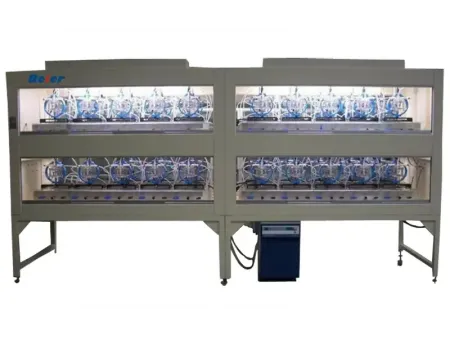Stress Corrosion Test Chamber
Request a Quote
The stress corrosion test chamber is designed to evaluate a material’s resistance to corrosion when exposed to both mechanical stress and corrosive environments. This testing method helps manufacturers assess material durability, failure risks, and long-term reliability in industries such as aerospace, automotive, marine, and electronics.
Basic Specifications
- Temperature Range: RT ±5°C (adjustable via air conditioning system)
- Humidity Range: 30% RH to 98% RH
- Humidity Deviation: ±5% RH
- Operation Time Setting: 0 to 9999 hours (adjustable cycle time)
Industries and Applications
- Metallurgy and Metal Processing: Used for testing copper alloys, steel, aluminum alloys, and other metal materials and products to assess their resistance to stress corrosion.
- Aerospace: Evaluates the durability of structural materials and components in aircraft, rockets, and other aerospace applications, ensuring long-term performance under extreme conditions.
- Automotive Manufacturing: Applied in testing car bodies, chassis, engines, and other key components to verify material strength and corrosion resistance.
- Petrochemical Industry: Used for testing pipelines, storage tanks, reactors, and other equipment that are exposed to corrosive environments in chemical processing and oil refining.
- Marine Engineering: Ensures the reliability of ship components and materials, helping manufacturers evaluate their resistance to seawater exposure and harsh marine conditions.
Components
- Corrosion-Resistant Construction: The inner chamber is made of anti-corrosion materials, while the outer frame consists of an aluminum alloy structure and PP panels, ensuring excellent resistance to corrosion.
- Control System: A PLC-based programmable controller combined with a user-friendly HMI manages the system. The 10-inch color touchscreen features a Chinese menu interface, a communication port for real-time monitoring, and displays key operational parameters, including temperature, humidity, H₂S concentration, gas supply pressure, and pH values. The system also records and stores test data for further analysis.
- Harmful Gas Monitoring: Equipped with H₂S sensors and instruments, the system continuously monitors and regulates hazardous gas levels. These sensors are integrated with the main control unit, ensuring safety and stability during testing.
- Pressure Monitoring and Control: The chamber includes a corrosion-resistant analog pressure gauge, providing precise control over the internal pipeline pressure.
- Exhaust Gas Absorption System: Uses a corrosion-resistant circulating water system with a dual-unit configuration, ensuring continuous and stable operation of the absorption system over long periods.
- H₂S Gas Supply System: Features imported stainless steel components, valves, and a dedicated H₂S gas safety cabinet. The metal pipelines are welded using an integrated process to prevent leakage during operation.
- Safety Features: Includes a gas exhaust and absorption system, H₂S leakage detection, and electrical fault alarms. The system is equipped with an emergency safety mechanism that automatically shuts down operations and triggers an alarm notification if a fault is detected.
